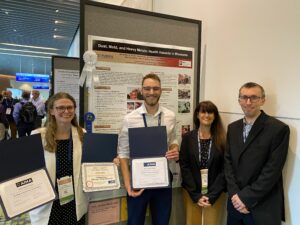
Elise Daugherty (IUPUI, Museum Studies), Johnathan Klicker-Wiechmann (Purdue University, Occupational and Environmental Health Sciences), Dr. Holly Cusack-McVeigh, and Dr. Mark Wilson
BY ELISE DAUGHERTY
Nashville, Tennessee is iconic for its country music, nightlife, and food, and in early May, it was also host to the American Industrial Hygiene (AIH) Conference and Expo. As a museum studies student, I was asked many times why I was attending a conference for industrial hygienists and what IH had to do with museums. In any place of work, risk management and the health of workers should be a priority. Museums face the unusual challenge of working with a variety of materials that may be inherently toxic or have been altered or treated with hazardous toxins. At the AIH conference, I had the opportunity to present research conducted over the fall 2021 semester with Purdue and IUPUI students addressing the health hazards present in three diverse collections.
Over the course of four months, our team looked to answer the question, “how can museums safely identify, assess, and mitigate toxins or poisons lurking in their collections?” Three case studies were conducted at the Indiana Medical History Museum (IMHM), the Eagle Creek Ornithology Center, and an FBI Art Crime collection which cumulatively house medical materials, natural history specimens, and ethnographic material. In consideration of the hazards associated with materials in the collections as well as the conditions of the environment, we analyzed hazards by quantifying the concentration of aerosolized dust, collecting mold spores, and using X-ray fluorescence to identify heavy metals. These samples resulted in the identification of heavy metals including arsenic, lead, and mercury in mostly small quantities. Many of the results were expected – for example, historic animal pelts in good condition were expected to have been treated with arsenic, and we found several that were. However, others left us with further questions. In one instance, a site had clear and visible mold, but the Bio-Tape slide samples did not reveal any particular mold species, indicating the need to test again using different methods, such as air sampling. Using tested samples in combination with observational and research data, we were able to identify and isolate certain hazardous materials and to introduce procedural changes, including a greater emphasis on PPE (such as gloves and masks) and methods for cleaning to keep the staff safe when handling and maintaining the collections.
While the student poster session provided the opportunity to share our research, the AIH conference also facilitated connections between museum professionals and programs and organizations focused on improving workplace health. During the Museum & Cultural Heritage Industry Working Group meeting, IUPUI professor of Anthropology and Museum Studies, Dr. Holly Cusack-McVeigh and Director of the Indiana Medical History Museum Sarah Halter (an IUPUI Museum Studies alum) shared about the unique needs and challenges of cleaning and caring for collections, notably that, unlike most spaces, a museum collection is often irreplaceable and cannot be treated the same way as other contaminated or hazardous workspaces. The speaker session held by Dr. Cusack-McVeigh, Sarah Halter, and Dr. Mark Wilson (Purdue University School of Health Science) on the partnership between industrial hygiene and museum studies students further illuminated the need for hazard recognition and mitigation in museums and the value of partnerships like this one.
The ability to network and learn from other museum and IH professionals at the AIH conference will continue to be invaluable as I begin my new position as the IUPUI Museum Studies Health Hazards Fellow at the Indiana Medical History Museum this fall.
Click here to view the poster.
Elise Daugherty is a second year IUPUI MA Museum Studies student.

